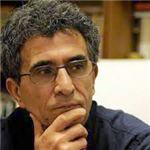
Abbas Maroufi
Abbas Maroufi (17 May 1957, Sangsar – 1 September 2022, Berlin) was one of the most original and daring voices of modern Persian fiction. A novelist, journalist, and editor, Maroufi belongs to the generation of Iranian writers whose formative years unfolded amid the cultural tensions of late Pahlavi Iran and whose literary maturity coincided with the post-revolutionary period of censorship, displacement, and existential reflection. Through his innovative use of narrative form and psychological depth, Maroufi redefined the possibilities of Persian prose in the late twentieth century.
Educated in dramatic arts at the University of Tehran, Maroufi’s early engagement with theatre profoundly shaped his literary sensibility. His fiction bears the marks of dramatic structure, polyphonic composition, and an acute attention to gesture and voice. While teaching literature and contributing to several cultural periodicals, he developed a critical awareness of the ways in which artistic expression could challenge or subvert the ideological boundaries imposed by political authority.
From 1990 to 1995, Maroufi served as editor-in-chief of the literary magazine Gardun (“The Orbit”), which he transformed into one of the most vibrant intellectual forums of post-revolutionary Iran. Gardun championed experimental writing, defended artistic freedom, and introduced a generation of readers to new literary aesthetics. Its eventual banning by the authorities reflected the larger conflict between creative autonomy and the state’s cultural orthodoxy—a tension that haunted much of Maroufi’s own fiction.
Maroufi’s first collection, Into the Sun, announced a writer concerned with the moral and emotional dislocation of modern life. His subsequent works continued to explore the fractures within the Iranian psyche: the disintegration of family and tradition, the burden of memory, and the inner struggle between desire and repression. His breakthrough novel, Symphony of the Dead (Sonāte-ye Mordegān, 1989), stands as a landmark of modern Persian fiction. Structured as a four-movement symphony, the novel weaves multiple narrative voices into a tragic family saga set in the city of Ardabil. Drawing on stream-of-consciousness techniques, interior monologue, and temporal dislocation, Maroufi transforms a local narrative into a universal meditation on guilt, madness, and the tyranny of silence. The novel’s intricate musical design and psychological realism recall Faulkner, Woolf, and Joyce, yet its moral imagination remains distinctly Persian.
In later works such as The Year of Turmoil (Sāl-e Balvā), The Body of Farhad, Fereydoon Had Three Sons, Completely Special, and Melted, Maroufi continued to probe the intersection of personal trauma and collective history. His characters are often trapped between the ruins of tradition and the false promises of modernity, between exile and belonging. Maroufi’s prose—lyrical yet unsparing—reveals a sustained engagement with the aesthetics of memory, and with what might be called the metaphysics of loss: the recognition that modern Iranian identity is forever shadowed by displacement and unfulfilled longing.
A student and admirer of Houshang Golshiri, Maroufi extended the modernist project inaugurated by his teacher, yet his work is more openly tragic and musical in temperament. Where Golshiri’s modernism sought renewal through linguistic precision and irony, Maroufi’s art was symphonic and emotional, seeking harmony in fragmentation. His engagement with European literary modernism was never imitative but dialogic—an attempt to inscribe Persian experience into a broader, transnational narrative of artistic defiance.
Following increasing restrictions on his editorial work, Maroufi emigrated to Germany, where he founded Hedayat Bookshop in Berlin—a symbolic gesture linking him to Sadegh Hedayat, the father of modern Persian prose. The bookstore became a cultural sanctuary for exiled Iranian writers and readers, and Maroufi himself remained deeply committed to nurturing the next generation through creative writing workshops and mentorship. In exile, his fiction turned increasingly introspective, addressing the psychic cost of displacement and the endurance of creativity amid loss.
An English translation of Symphony of the Dead appeared in 2007, extending Maroufi’s readership beyond the Persian-speaking world, while several of his works were translated into German and other European languages. His literary legacy lies not only in his novels but also in his role as a mediator between Iran’s literary modernism and the diasporic imagination.
Abbas Maroufi passed away in Berlin on 1 September 2022, at the age of sixty-five. His death marked the passing of a writer who, through exile and adversity, remained faithful to the moral vocation of literature: to speak for the silenced, to bear witness to suffering, and to rescue beauty from the ruins of history.